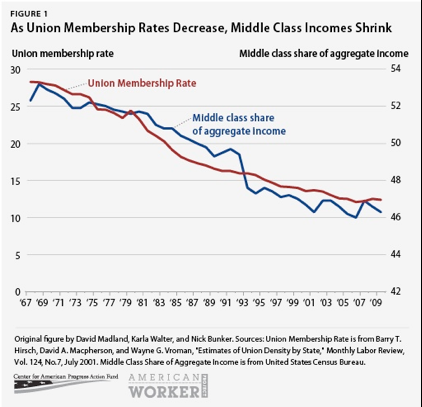Unions Make Democracy Work for Working Families
October 29, 2012
By CWA Local 1180 President Arthur Cheliotes
 I’m often asked if unions are important in our new economy. I respond by pointing out if we didn’t have unions the middle class would not exist and our democracy would be in jeopardy. I go on to explain look at what has happened to the middle class over the last 30 years as unions in the private sector declined. Consider how money now plays a dominant role in elections and how voter suppression has become routine.
I’m often asked if unions are important in our new economy. I respond by pointing out if we didn’t have unions the middle class would not exist and our democracy would be in jeopardy. I go on to explain look at what has happened to the middle class over the last 30 years as unions in the private sector declined. Consider how money now plays a dominant role in elections and how voter suppression has become routine.
There is a report that backs up my response by David Madland and Nick Bunker for the Center for American Progress Action Fund. The report explains the role unions play in making sure our democracy works to build the middle class. The full report and all the graphs can be found at http://www.americanprogressaction.org/issues/labor/report/2012/01/25/10913/unions-make-democracy-work-for-the-middle-class
In the report they point out that even though less than 12 percent of all workers are currently union members, Americans—whether unionized or not—should care about this decline because unions give workers a bigger say in our economy and our political system. That helps the middle class, and it’s good for democracy.
The report summarizes a number of academic studies that find unions strengthen the middle class and significantly reduce economic inequality. In fact studies indicate that the decline in union density explains as much of today’s record level of inequality as does the increasing economic return of a college education.
They point out that research on the importance of unions to the middle class tends to focus on how unions improve market wages for both union and nonunion workers. But that gives short shrift to the critical role unions play in making democracy work for the middle class.
Unions help boost political participation among ordinary citizens—especially among members, but also among nonunion members—and convert this participation into an effective voice for pro-middle-class policies.
Madland and Bunker put together a series of charts that explains why states with a greater percentage of union members have significantly higher voter turnout rates, as well as higher minimum wages, a greater percentage of residents covered by health insurance, stronger social safety nets, and a more progressive tax code. The charts available at the link above illustrate these facts.
Doubters can see that unions are important to the strength of the middle class is easy to see by looking at the close relationship between the two over time. In 1968 the share of income going to the nation’s middle class was 53.2 percent, when 28 percent of all workers were members of unions. Since then, union membership steadily declined alongside the share of income going to the middle class. By 2010 the middle class only received 46.5 percent of income as union membership dropped to less than 12 percent of workers. (see graph below)

They conclude with the following: Many argue that unions are just another interest group, but the fact is that organized labor fights for the common interests of many Americans. Unions have in many ways helped workers who have never paid union dues in their lifetimes.
What’s more, the role unions play in making our democracy work is critical at this juncture when inequality is at record levels and an increasing number of citizens feel their democracy is no longer responsive to their needs. Indeed, in 2009, 59 percent said they don’t think most elected officials care what people like them think, up 10 percentage points from 1987—a time when unions were stronger and inequality lower.
In short, rebuilding the strength of organized labor is necessary if we intend to make democracy work for the middle class. So when others ask you what do unions do to improve their lives have them read the full report at the link above.







